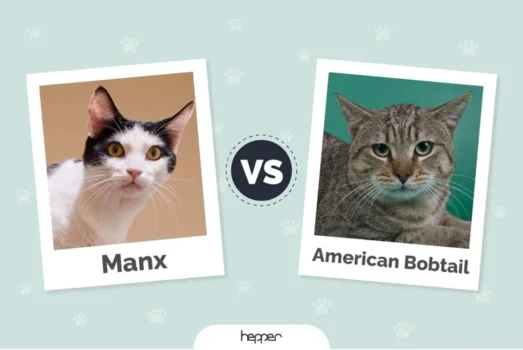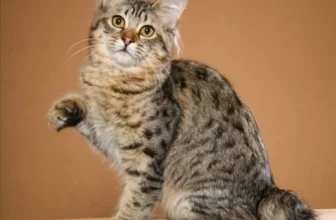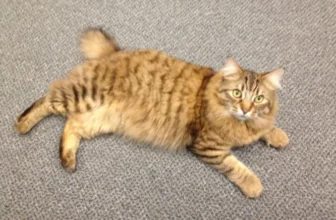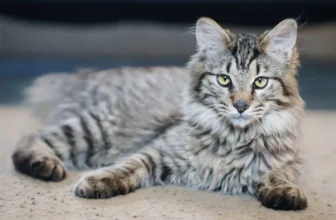As cat lovers, we often marvel at the unique traits and characteristics of our feline friends. One particular breed, the American Bobtail, has caught the attention of many due to its striking resemblance to its Manx ancestors. But what is the role of Manx in American Bobtail evolution? What traits and characteristics do these cats share with their forebears, and what makes them stand out as a distinct breed in their own right? In this article, we’ll delve into the history of the Manx and the American Bobtail, explore the influence of one breed on the other, and discuss essential care tips for these beloved pets. So, let’s get started!
The History of the Manx Cat
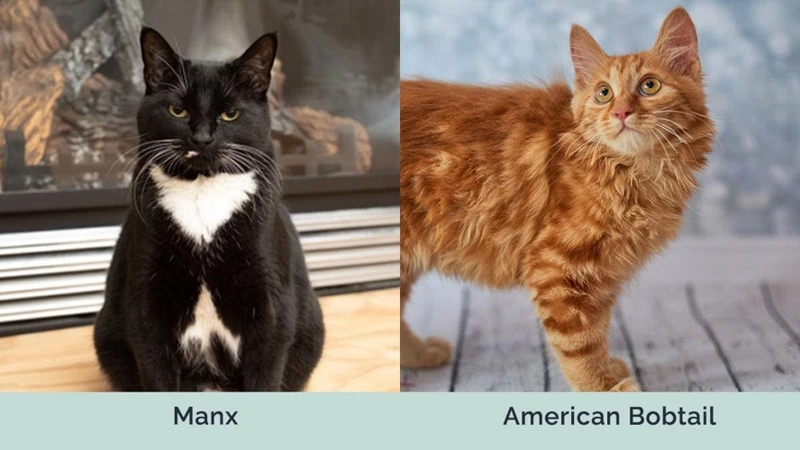
The Manx cat is a unique feline breed that has captured the hearts of many cat-lovers around the world. This breed of cat stands out due to its distinctively short tail, which is a direct result of its genetic makeup. However, the history of the Manx cat is clouded in mystery, and its origins have been the subject of much debate among researchers and animal enthusiasts alike. In this section, we will explore the fascinating history of the Manx cat, including its origins and the development of the breed over time. (No relevant internal link to add)
Origins of the Manx
The Manx cat, a breed known for its lack of tail, has an interesting origin story. One theory suggests that the Manx originated on the Isle of Man, an island in the Irish Sea, and was brought there by Phoenician traders. Another theory proposes that the Manx breed has existed for centuries and was brought to the Isle of Man by Viking explorers.
Interestingly, the Manx’s taillessness is not a result of breeding, but rather a genetic mutation. This mutation causes the tail to be either very short or nonexistent altogether. This unique genetic feature is what sets the Manx breed apart from other felines.
Although there is no definitive answer as to when the Manx breed was first developed, they have been mentioned in literature as early as the 1700s. The breed’s tailless trait has intrigued many people throughout history, including Charles Darwin, who conducted his own studies on the breed.
The Manx breed’s origins can be traced to the Isle of Man, and their unique lack of tail is caused by a genetic mutation rather than breeding.
Development of the Breed
The Manx cat has a unique body structure, which has been the result of years of breeding and development. The development of the Manx cat began on the Isle of Man, where a population of cats with unique short or no tail appeared. These cats were bred with other breeds, such as British shorthairs and Siamese cats which resulted in the Manx cat as we know it today.
During the development of the Manx breed, breeders focused on creating a cat that was both attractive and healthy. As a result, the Manx cat has a muscular body, short legs, and a round head. The breed also has a thick fur coat that comes in a variety of colors and patterns.
The Manx breed was officially recognized by cat associations in the early 1900s. Since then, the breed has become increasingly popular, especially in the United States. Manx cats have been a source of inspiration for cat breeders in the US who were looking to develop their own unique breed.
One of these breeds is the American Bobtail. The American Bobtail originated in the 1960s when a short-tailed brown tabby kitten was found on an Indian reservation in Arizona (source). This kitten was bred with other breeds such as the Siamese, Himalayan, and Burmese cats to develop a breed with a short tail and a muscular body similar to the Manx.
Crossbreeding played a significant role in the development of the American Bobtail. Breeders introduced new breeds into the gene pool to improve the breed’s health and appearance. The Manx breed was one of the most influential breeds that contributed to the evolution of the American Bobtail (source).
Environment also played a crucial role in the development of the American Bobtail. The breed evolved in different regions of the United States, which is why there are slight variations in the breed’s appearance and temperament (source).
Today, the American Bobtail breed is recognized by major cat associations and is known for its muscular body, short tail, and affectionate personality. The breed has also inspired the creation of new cat breeds, such as the Highlander cat (source).
American Bobtail Origins
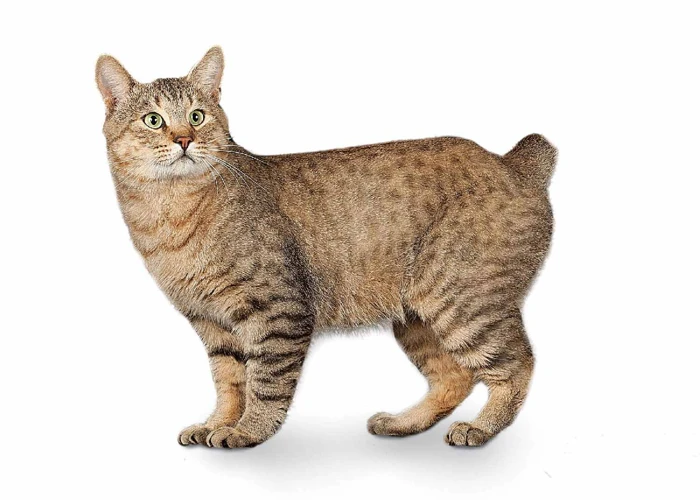
The American Bobtail is a breed of cat that has a distinctive wild appearance, but did you know that it owes its origins to a chance encounter with a unique feline? The history of this feline is closely intertwined with the history of the Manx, a tailless breed that can trace its roots back centuries. While the American Bobtail has its own distinctive traits, it wouldn’t exist without the influence of the Manx. Let’s take a closer look at how this breed came to exist and how the Manx played a vital role in its development. For more information about American Bobtail characteristics, check out our article here.
The Beginnings of the Breed
The American Bobtail cat breed has an interesting history! Its origins can be traced back to a short-tailed male kitten, picked up from an Indian reservation by John and Brenda Sanders in Arizona in the 1960s. Although the kitten didn’t have a pedigree, it had a distinctive appearance and personality. The Sanders started a breeding program and in 1969, the first litter was born.
Aspects of the breed’s development are:
| Year | Event |
|---|---|
| 1969 | The first litter of American Bobtail kittens was born. |
| 1970s | The breeding program was established and the Sanders began collaborating with other cat breeders. |
| 1989 | The breed was recognized by The International Cat Association (TICA). |
| 2000 | The breed was recognized by the Cat Fanciers Association (CFA). |
Interestingly, the genetics behind the American Bobtail breed are still not completely understood. It is believed that the breed’s short tail is caused by a dominant genetic mutation, but the exact gene responsible for this trait has not yet been identified.
Despite this uncertainty, the American Bobtail breed has continued to grow in popularity. This may be due in part to the breed’s affectionate and playful nature, as well as their distinctive and eye-catching appearance. It’s no wonder that these cats have become a beloved fixture in many American households!
Influence of Manx on the Breed
The Manx cat has played a significant role in the creation and development of the American Bobtail breed, making its influence on this unique feline breed undeniable. Here are some ways the Manx has influenced the American Bobtail:
- Short tail: The most significant influence of Manx on the American Bobtail breed is their characteristic short tail. American Bobtails owe their unique tail to the Manx, which carries a gene that shortens the tail considerably. The resulting bobtail on the American Bobtail is varied, with some having no tail at all, while others have a shorter or longer tail.
- Strong hind legs: Manx cats are known for their powerful hind legs, which enable them to jump exceedingly high. These felines come from the Isle of Man, where they were originally bred for hunting rodents. Bobtails, too, are remarkably agile, in part due to the Manx genetics they inherited, which gives them a significant advantage in exploring their environments.
- Playful personality: Both breeds have playful personalities and are great with children. Manx cats, in particular, are known for their affectionate and intelligent nature, making them an excellent companion for families. American Bobtails inherited these traits as well and have a reputation for being affectionate, friendly, and good with children.
- Round face: The Manx has a distinctive round face that is a result of its shorter snout. The American Bobtail breed also has a round face, a characteristic that has become synonymous with the breed.
- Thick coat: Both breeds have thick, dense coats that protect them from harsh weather conditions. The Manx’s coat is shorter, but American Bobtails have longer, shaggier coats that require regular grooming to keep them looking their best.
Without the influence of the Manx, it’s hard to imagine what the American Bobtail would look like today. Its unique physical traits, playful personality, and affectionate nature are direct results of the Manx’s influence on the breed.
American Bobtail Traits
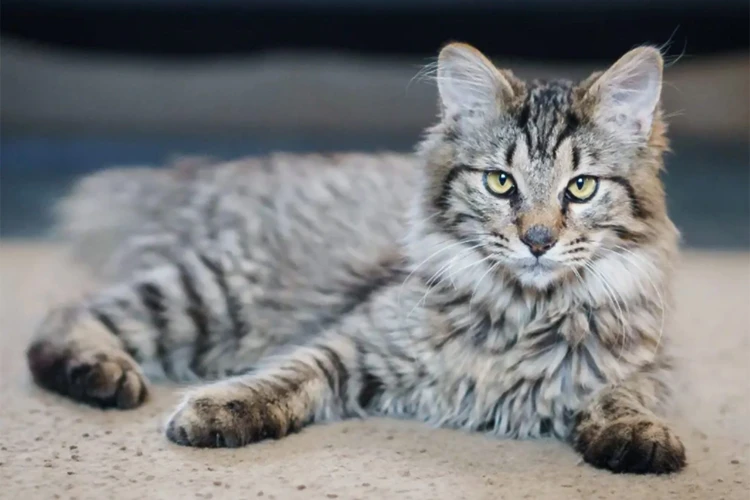
The American Bobtail is one of the most unique and charming breeds of cats, known for their distinct physical features and playful temperament. This breed has gained popularity in recent years, thanks in part to their distinctive bobbed tail, short fur, and expressive eyes. In this section, we’ll take a closer look at the specific traits that make American Bobtails one-of-a-kind feline companions. From their physical characteristics to their personalities, these incredible cats are truly a wonder to behold. So let’s explore their traits together and unravel the beauty of the American Bobtail.
Physical Characteristics
When it comes to physical characteristics, the American Bobtail is a stunning breed with a unique appearance that sets it apart from other cats. Their muscular and athletic build is combined with a thick, shaggy coat, giving them a wild appearance that complements their independent spirit. Let’s take a closer look at some of the American Bobtail’s distinguishing physical traits:
| Physical Trait | Description |
|---|---|
| Body Type | The American Bobtail is a medium to large-sized breed with a sturdy, muscular build. They have a broad chest, strong legs, and a short, well-furred tail that is often kinked or curved. |
| Coat | The breed’s coat is thick, shaggy, and can come in a variety of colors and patterns. It is water-resistant and insulating, making it ideal for cold climates. American Bobtails also have a ruff of fur around their necks, adding to their wild appearance. |
| Head | American Bobtails have a broad, modified wedge-shaped head with high cheekbones and a distinct brow. Their ears are medium-sized and can be slightly tufted, adding to their wild look. They have large, expressive eyes that can be any color, including blue, green, gold, or copper. |
| Paws | Their paws are round and large, with tufts of fur between their toes. They have a distinctive “thumb” on their front paws, which is caused by a genetic mutation similar to the one found in Manx cats. |
The American Bobtail’s physical characteristics make them a unique and beautiful breed. Their wild appearance is combined with a friendly personality, making them a favorite among cat lovers.
Temperament
When it comes to temperament, the American Bobtail is an ideal companion that possesses several unique qualities. Here are some important bullet points to highlight the temperament of the American Bobtail:
- Intelligence: This breed is known for its intelligence and problem-solving abilities. It is smart enough to learn new tricks and obey commands quickly.
- Playfulness: American Bobtail loves to play and can keep itself entertained for hours. It is always ready for a game of fetch or a wrestling match with its human family members.
- Curiosity: These cats have a keen sense of curiosity which often leads them into mischief. They love to explore and have a knack for getting into tight spaces.
- Loyalty: American Bobtails are loyal and affectionate towards their owners. They are constantly seeking attention and love nothing more than curling up in their owner’s lap for a good cuddle session.
- Independence: Despite being social creatures, American Bobtails are quite independent and can entertain themselves for hours on end. They do not have a high-maintenance personality and are content with simple pleasures like playing with a toy or lounging in a sunbeam.
- Good with Kids: American Bobtails are known for their gentle nature and patient demeanor, making them great companions for children. Their playful demeanor and loving personality make them a popular choice for families with kids.
The American Bobtail has an amiable temperament that makes it a great addition to any household. They are loyal, intelligent, and playful, and with proper care, they will quickly become a beloved member of their family.
Caring for American Bobtails
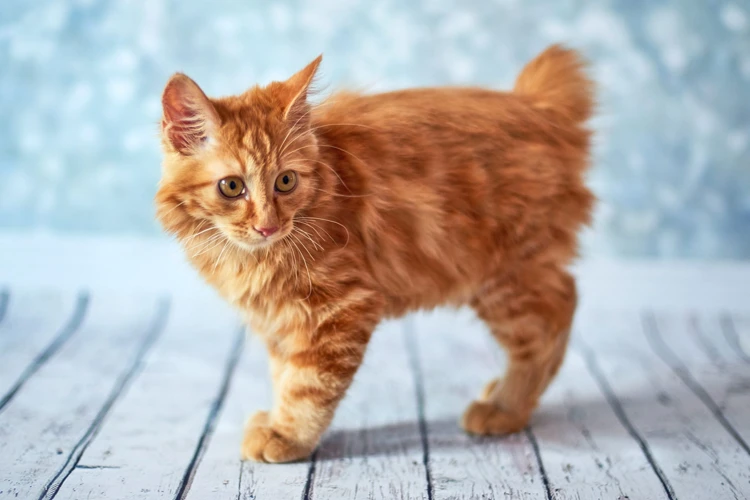
When it comes to taking care of a beloved pet, it’s important to give them the attention and care they deserve. This is especially true for American Bobtails, a unique breed of feline with distinct physical and temperamental traits. Whether you’re a new owner or a long-time caretaker, understanding the nutritional, grooming, and exercise needs of these cats is essential to their health and wellbeing. In this section, we’ll take a close look at the best ways to care for your American Bobtail and keep them happy and healthy for years to come.
Nutrition
A healthy and balanced diet is essential for maintaining the well-being of American Bobtail cats. Proper nutrition ensures that they have the energy they need to stay active and play, while also supporting their overall health. Here are some important tips to keep in mind when feeding your American Bobtail:
- Choose high-quality food: Look for cat food that is made with real meat as the first ingredient, as cats are natural carnivores and need a protein-rich diet. Avoid foods that include a lot of fillers or artificial ingredients.
- Measure servings: Overfeeding can lead to obesity, which can cause a host of health issues. Use a measuring cup or scale to portion out the appropriate amount of food for your cat based on their weight and activity level.
- Avoid human foods: While it may be tempting to share your food with your American Bobtail, many human foods can be toxic to cats. Foods like onions, garlic, and chocolate should always be avoided.
- Offer variety: Just like humans, cats can get bored of eating the same thing every day. Mix up your cat’s diet by offering different flavors and textures of food, as well as treats in moderation.
- Stay hydrated: Make sure your American Bobtail always has access to fresh, clean water. Some cats prefer to drink running water, so consider investing in a fountain-style water bowl to encourage them to drink more.
Following these tips can help ensure that your American Bobtail stays healthy and happy for years to come. If you have any concerns about your cat’s diet or nutrition, it’s always best to consult with your veterinarian.
Grooming
American Bobtails are generally low-maintenance when it comes to grooming. They have thick and medium-length coats that require minimal bathing and brushing. However, regular grooming still plays a key role in maintaining your cat’s overall health and appearance.
Brushing:
Brushing once or twice a week is sufficient to keep your American Bobtail’s coat healthy and shiny. A slicker brush or a grooming glove can be used to remove loose hair and prevent matting. Using a steel comb can help remove any lingering tangles.
Bathing:
Bathing American Bobtails should be done only when necessary, as they tend to keep themselves clean. If you do give your cat a bath, make sure to use a cat-specific shampoo and rinse them thoroughly to prevent any irritation.
Nail Trimming:
Trimming your cat’s nails once a week can help prevent them from getting too long and causing discomfort or snagging on surfaces. Regular nail trimming can also help prevent damage to furniture and clothing.
Ear Cleaning:
Cleaning your cat’s ears once a month can help prevent ear infections and remove any buildup of wax or debris. Use a cotton ball moistened with cat-specific ear cleaner to gently wipe the outer ear canal. However, never insert anything into the ear canal as it can cause damage.
To make grooming a positive experience for your cat, make sure to reward them with treats and praises. Additionally, keep a regular check on your cat’s coat, nails and ears to pick up on any signs of health issues.
Exercise and Play
Providing opportunities for exercise and play is essential for the well-being of American Bobtails. These cats are active and playful by nature, and they need plenty of physical activity to stay in good shape.
Indoor activities: Being indoor cats, American Bobtails can engage in various forms of indoor activities such as playing with toys, climbing towers, and scratching posts. Giving them access to toys like balls, stuffed toys, and interactive toys can help keep them active and entertained. A scratching post can provide them with a means of exercise, as they can scratch and climb it. Climbing towers are also a great option for this breed, as they love to climb to high places.
Outdoor activities: American Bobtails that have access to a secure, outdoor space can benefit from various outdoor activities. They love to explore and hunt, so providing them with opportunities to roam and explore is vital. Providing them with a secure outdoor enclosure is a great option as it allows them to feel the fresh air and sunshine, while staying safe.
Playing with their owners: American Bobtails adore playtime with their owners. Playing fetch, using a laser pointer or even just playfully interacting with their owners, can provide them with the exercise they need, and strengthen their bond with their owner.
As with any cat breed, it is essential to provide plenty of exercise and play opportunities for American Bobtails. This ensures they stay healthy, active, and happy.
Health Concerns
Taking care of your American Bobtail’s health is crucial to ensure they live long and happy lives. While generally considered a healthy breed, there are a few health concerns to keep in mind.
Spinal Problems: Feline Spinal Muscular Atrophy (FSMA) is an inherited disease that affects the nerves in the spinal cord of cats. Cats with FSMA may have trouble walking, weak hind legs, and difficulty jumping. This disease is more common in Manx cats but can occur in American Bobtails as well due to their shared genetic ancestry. To prevent the onset of FSMA, it is recommended to only adopt American Bobtails from reputable breeders who test their cats for the disease.
Hypertrophic Cardiomyopathy: This is a genetic heart disease that affects many breeds of cats, including the American Bobtail. HCM is characterized by thickening of the heart muscle, which can lead to heart failure if left untreated. Symptoms may include coughing, difficulty breathing, and lethargy. To prevent or manage HCM, it is important to take your American Bobtail to regular vet check-ups and screenings.
Obesity: American Bobtails are prone to obesity, which can lead to a range of health problems such as diabetes, arthritis, and heart disease. As a relatively inactive breed, American Bobtails should be fed a balanced diet and given opportunities for exercise and play.
Urinary Tract Issues: Like many cats, American Bobtails are vulnerable to urinary tract problems. Signs of UTIs or urinary blockages include difficulty urinating, discolored or cloudy urine, and excessive licking of the genital area. To prevent these issues, it is important to feed your American Bobtail a high-quality diet, provide plenty of fresh water, and clean their litter box regularly.
While American Bobtails are generally healthy cats, it’s important to be aware of these potential health issues to ensure they stay happy and healthy. Regular vet check-ups, a healthy diet, and plenty of exercise and play are key to keeping your American Bobtail in top shape.
Conclusion
In conclusion, the Manx cat has had a significant impact on the evolution of the American Bobtail breed. While the origins of the Manx are uncertain, it is believed that the breed developed on the Isle of Man over several centuries. The genetic mutation that led to the Manx’s tailless trait is unique to the breed and has been the subject of scientific study.
The American Bobtail breed has a similarly interesting history, having developed in the 1960s as a result of a mating between a domestic shorthair and a wild bobcat. The breed’s physical characteristics, including its short tail and sturdy build, make it a unique and attractive pet for many cat lovers.
The Manx’s influence on the American Bobtail was significant, primarily due to the taillessness trait that both breeds share. This genetic trait brought greater diversity to the American Bobtail’s unique appearance, as well as contributing to its overall health and temperament.
When caring for an American Bobtail, it’s important to keep in mind their unique dietary and exercise needs. Feeding your cat a high-quality, protein-rich diet and providing opportunities for play and exercise will help keep them healthy and happy.
While both breeds are generally healthy, it’s important to be aware of potential health concerns. For the Manx, spinal cord problems can be a risk due to their shortened tails. Likewise, American Bobtails are susceptible to hip dysplasia and hypertrophic cardiomyopathy.
In summary, the Manx’s influence on the American Bobtail breed has been notable, providing unique physical traits and a shared taillessness characteristic. Proper care and attention to potential health concerns ensure that these captivating felines remain healthy and happy companions for years to come.
Frequently Asked Questions
What is a Manx Cat?
A Manx cat is a breed of cat that is known for its distinctive lack of a tail. They come in both longhair and shorthair varieties and are said to have originated on the Isle of Man.
What is the History of the Manx Cat?
The Manx cat has a long and fascinating history that dates back hundreds of years. It is said that they were first brought to the Isle of Man by the Vikings and have been living there ever since.
What are the Origins of the Manx Cat?
The origins of the Manx cat are somewhat shrouded in mystery, but it is believed that they are descended from cats that were brought over to the Isle of Man by the Vikings. They were then bred with other local cats to produce the breed that we know today.
What is the Development of the Manx Cat Breed?
The development of the Manx cat breed is a long and fascinating one. The breed has changed and evolved over time, with different traits being selected for by breeders to produce the cat that we know and love today.
What are the Origins of the American Bobtail?
The American Bobtail is a breed of cat that was first developed in the United States in the 1960s. Its origins are somewhat unclear, but it is believed to be descended from a mixture of different breeds of cat.
How has the Manx Cat Influenced the American Bobtail Breed?
The Manx cat has had a significant influence on the development of the American Bobtail breed. It is believed that the original American Bobtail cats were crossed with Manx cats to produce the distinctive short, stubby tail that the breed is known for.
What are the Physical Characteristics of the American Bobtail?
The American Bobtail is a medium to large-sized cat with a muscular build and a short, stubby tail. They come in a variety of different colors and patterns, and have a distinctly wild and untamed appearance.
What is the Temperament of the American Bobtail?
The American Bobtail is a friendly and sociable cat that is known for its intelligence and loyalty. They get along well with children and other pets, and are known to be playful and affectionate.
How Should I Care for my American Bobtail?
Caring for an American Bobtail requires a bit of effort, but it is well worth it. They need to be fed a high-quality diet, groomed regularly, and given plenty of exercise and playtime in order to stay healthy and happy.
What Health Concerns Should I be Aware of with the American Bobtail?
The American Bobtail is generally a healthy breed of cat, but there are a few health concerns that owners should be aware of. These include hip dysplasia, heart murmurs, and spinal cord defects.
What is the Conclusion of the Role of Manx in American Bobtail Evolution?
The Manx cat has played a significant role in the evolution of the American Bobtail breed. Its influence can be seen in the distinctive short, stubby tail of the American Bobtail, which is believed to have been developed through the crossing of Manx cats with other breeds.

